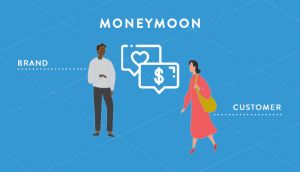13 Mar How to take advantage of the ‘moneymoon’ period to drive customer loyalty

Congratulations, your latest campaign was a success – you’ve attracted new customers. It’s a coup for the business, you receive a pat on the back, job well done….and then what? Probably onto the next sales campaign, yes?
82% of companies agree that retention is in fact cheaper than acquisition¹. Yet despite this spend the majority of their efforts on acquiring customers, thinking that this alone will grow their business – this however, is not the case. The customer risks becoming yet another number in the email list.
So, what is the moneymoon period? How do you take appropriate advantage of the customers current mindset to drive customer loyalty? Here are our thoughts on what the path to repurchase customer journey should look like.
The moneymoon period
A customer has recently bought a product or service from you. The chances are that the customer is feeling positive about your brand and their overall experience with you – we refer to this as ‘the moneymoon period’. What you do next is crucial – don’t allow buyers remorse to set in by delivering a poor post-purchase experience.
Firstly, let’s look at what you should NOT be doing:
- Putting your satisfaction score first
You’d be surprised how many brands selfishly contact a customer straight after their purchase, simply asking ‘would you recommend us to your friends and family?’. These companies are clearly too focused on improving their NPS score, rather than establishing any form of relationship with the customer.
- Share irrelevant content
Are you contacting them with relevant content, or bombarding their inbox with generic ‘one size fits all’ emails? If a customer came into a store to buy a mans jacket, it’s highly unlikely they will be interested in learning about the latest womens shoe range the following week. That won’t make them feel valued as a customer, and it’s also not continuing the original conversation with them.
- Contact the customer too frequently
If you’re contacting the customer multiple times a week, you can be sure they will become annoyed and frustrated. They’ve trusted you with their personal information – don’t abuse that trust. The customer will stop engaging, deleting emails/SMS as they arrive, because they’ve already reached the conclusion that it won’t be relevant to them. This inevitably leads to them pressing the unsubscribe button – and you’ve potentially lost them as a customer forever.
- Not personalising the experience
Personalisation is key! It’s back to our original example of mens jacket vs womens shoes. To continue the conversation with the customer, you need to be relevant.
What should the path to re-purchase look like?
- Recognise the customer
The first time you contact the customer, rather than trying to sell them something else, or asking if they would recommend you – how about a genuine ‘thank you’. Thank them for shopping with you, for choosing you above other brands – without asking them for anything in return. This is simple, yet unbelievably effective.
- Check in with the customer
Learn how the product they purchased is performing – ask if it is meeting their needs and expectations. Make sure they don’t have any concerns/issues. If they do, now is your chance to offer resolution. Do they have any questions? Can you provide any additional help? Always be available for them – without expecting anything in return.
- Appropriate communication with the customer
Keep it relevant, don’t send an email every other day if your typical customer buying cycle is only a couple of times a year. Communicate when they’re most likely to be interested and engaged. A great example of a brand with a highly effective customer lifecycle management program is Bridgestone Australia. Their members program ‘Bridgestone benefits’ sends scheduled communications to customers who have purchased new tyres reminding them to book an in-store tyre check at appropriate intervals. They contact the customer when they can add value, instead of bombarding them every week with the latest offers.
- Continue the conversation
We cannot stress this enough. Remember this is a two-way relationship. You should be talking WITH your customers, not AT them.
Summary
The moneymoon period provides a great opportunity for you to build lasting engagement with your customer. You can easily erode this by bombarding the customer with regular, irrelevant content, and by treating them as a number on an email list.
The customer should feel respected and valued. Continue the conversation with the customer, this will help build trust, credibility and ultimately lead to repeat purchases, improving the customer lifetime value. It will also catapult the customers from ‘I would recommend you’ to ‘I am recommending you’.
How does your brand communicate with customers during the moneymoon period? Customology are specialists in identifying and implementing customer-focused solutions to businesses. Contact a Customologist today on 07 3902 7700 or hi@customology.com.au for more information on how your business can enhance the moneymoon period and customer lifecycle management to drive customer loyalty.
Subscribe to receive our latest insights
¹ Oracle

